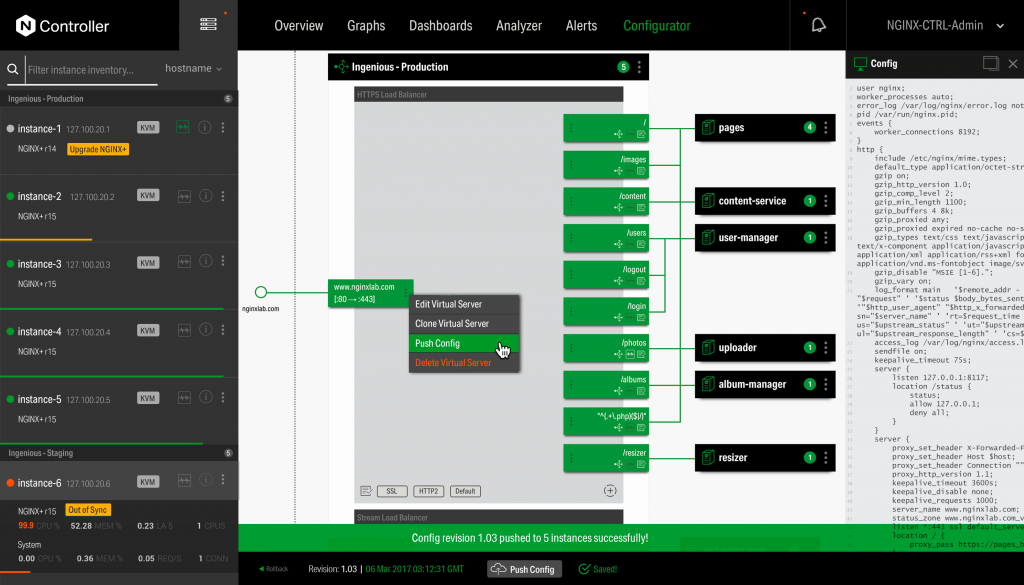Nginx Smoothes the Path to Microservices

The Nginx Inc. company behind the open-source Nginx web server software is doubling down on microservices by positioning itself as a one-stop shop for helping customers make the transition.
The company has introduced new capabilities to further extend Nginx as an API gateway, Kubernetes ingress controller and service mesh.
“When people are looking at how to deliver their applications, there are a lot of tools and vendors out there, they’re changing very quickly and a lot of them aren’t even supported. For enterprise customers, it’s a risky proposition, so simplicity is an important thing they’re looking for,” said Sidney Rabsatt, vice president of product management.
The company is focused on helping people architect their applications however it makes sense, whether that is in containers or not, he said, though he pointed to 1 billion pulls of its software from the Docker store as evidence that containers remain a popular option.
In a 2016 episode of The New Stack Makers podcast, Nginx CEO Gus Robertson and other execs explained why the company’s commercial offering is a good fit for microservices.
A new version of its core software, Nginx Plus R15, will be available Tuesday. It will provide more intelligent clustering capabilities so instances can be more aware of things their peer instances are doing, he said.
It provides enhanced support for HTTP2 specific to server push and gRPC, Google’s microservices networking protocol. It provides an identity layer on top of the OAuth 2.0 authorization protocol and OpenID Connect for improved authentication and communication between services. These improve performance and simplify microservices stacks where Nginx runs as a web server, load balancer, API gateway, Kubernetes ingress controller or sidecar proxy, according to the company.
“On the data plane, we’ve made sure we have more hooks and can be successful as a connective tissue,” Rabsatt said.
While Nginx’s claim to fame has been as a web server — nearly 1.8 million web-facing computers, 24.5 percent of the market, were running Nginx in March, according to Netcraft’s March 2018 report — it’s adding an application server.
Nginx Unit 1.0, a multi-level open source application server, will also be available later this week. It collapses the networking capabilities that proxy into application servers to provide a consistent way for different components to connect. It can run code commonly found in microservices and supports application-level logic. It initially will support five languages — Go, Perl, Python, PHP, and Ruby — with support for Java and JavaScript in the works. It runs at least 30 percent faster than other application servers, according to Rabsatt.
The NGINX Controller, which will be available in the second quarter, adds new monitoring dashboards, alerting, and management capabilities. It sits on top of both NGINX Plus and Unit and streamlines the way users can deploy their solutions and architect the application network they’re trying to deliver. In addition to enabling users to see how their configuration works, it will include an analyzer capability that will recommend ways to fine-tune it to get better performance, better compliance and security.
Last fall the company announced ties with the Istio project, offering Nginx as an ingress controller. The extensible Controller architecture is designed to integrate control-plane solutions like Istio, eliminating the need for enterprises to deploy multiple frameworks to manage a service mesh.
While customers increasingly are considering microservices, the reality is that not all applications will eventually be transitioned to that type of architecture and organizations will maintain some intermediate state for a long time, Rabsatt said.
“The theme through all of this is providing a single, consistent set of capabilities as opposed to having multiple tools stitched together, always changing and having to be synchronized. We have a simple, single interface and set of capabilities across all of this. We allow people to get started along this path and support them every step of the way,” Rabsatt said.
Feature image via Pixabay.

